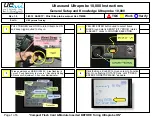
3.6 Connection Drawing
Ua
Uc Ub
Ia* Ia Ib* Ib Ic* Ic
6
A
B
C
N
24 25 26
28 29
27
Ua
Un
Ua
Uc
Ub
Un
23
21 22
20
24 25 26
28 29
27
23
21 22
20
24 25 26
28 29
27
23
21 22
20
24 25 26
28 29
27
23
21 22
20
24 25 26
28 29
27
23
21 22
20
24 25 26
28 29
27
23
21 22
20
low pressure: 3 phase 4 wires
Ua Ub Uc Un
Ia* Ia Ib* Ib Ic* Ic
A
B
C
N
Ua
Uc Ub
Ia* Ia
L
N
Ia* Ia
L
N
Ia* Ia
Ic* Ic
A
B
C
Ia* Ia
Ic* Ic
A
B
C
Ua
Un
①
When the input voltage is higher than the rated input voltage of the product, you should consider using a PT. For ease of maintenance, it is
recommended to use a wiring board.
。
②
The standard rated input current is 5A, 1A or greater than 5A, the external CT should be used. If there are other meters connected to the CT, the wiring
should be connected in series. Before removing the current input connection of the product, it is necessary to disconnect the primary circuit of the CT
or short the secondary circuit. It is recommended to use the terminal block for maintenance.
③
To ensure that the input voltage and current correspond, the phase sequence is consistent and the direction is the same, otherwise there will be errors
in the values and symbols of power and energy, etc.
。
④
The instrument can work in 3 phase 4 wires mode or 3 phase 3 wires mode. The user should select the appropriate wiring mode according to the field
use conditions. The 3 phase 3 wires mode is generally used without a center line, and the 3 phase 4 wires mode is used with a center line. It should be
noted that the on-site wiring must be the same as the wiring set in the meter, otherwise the meter's measurement data is incorrect.
Note:
low pressure: 3 phase 3 wires
high pressure: 3 phase 4 wires
low pressure: 3 phase 3 wires
low pressure: single phase
high pressure: single phase









































